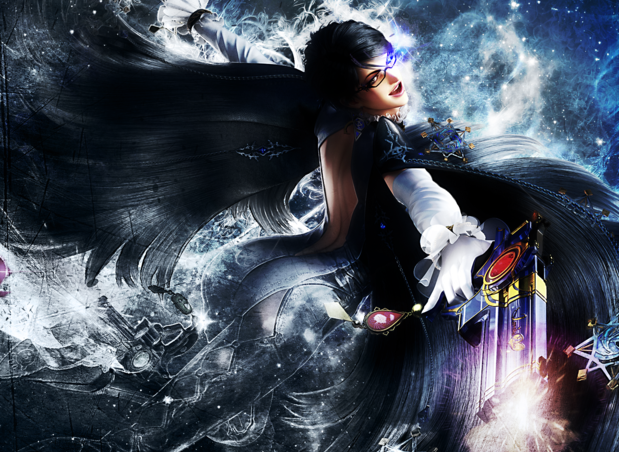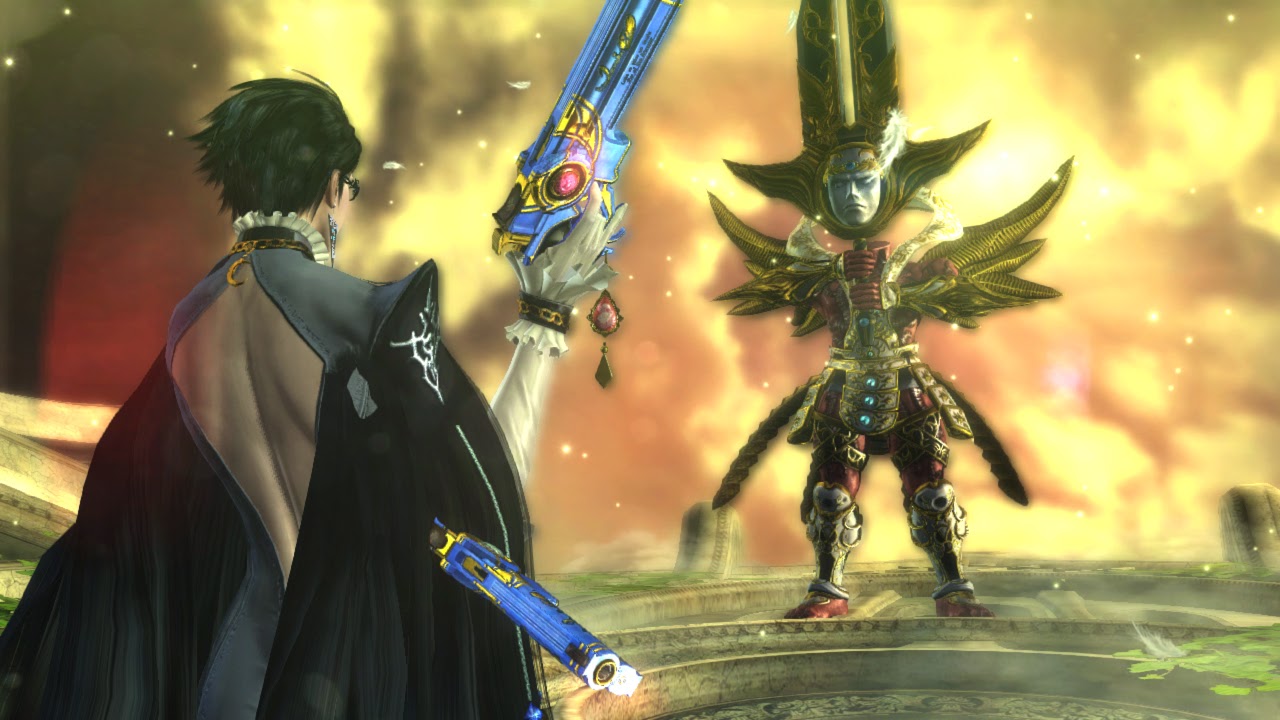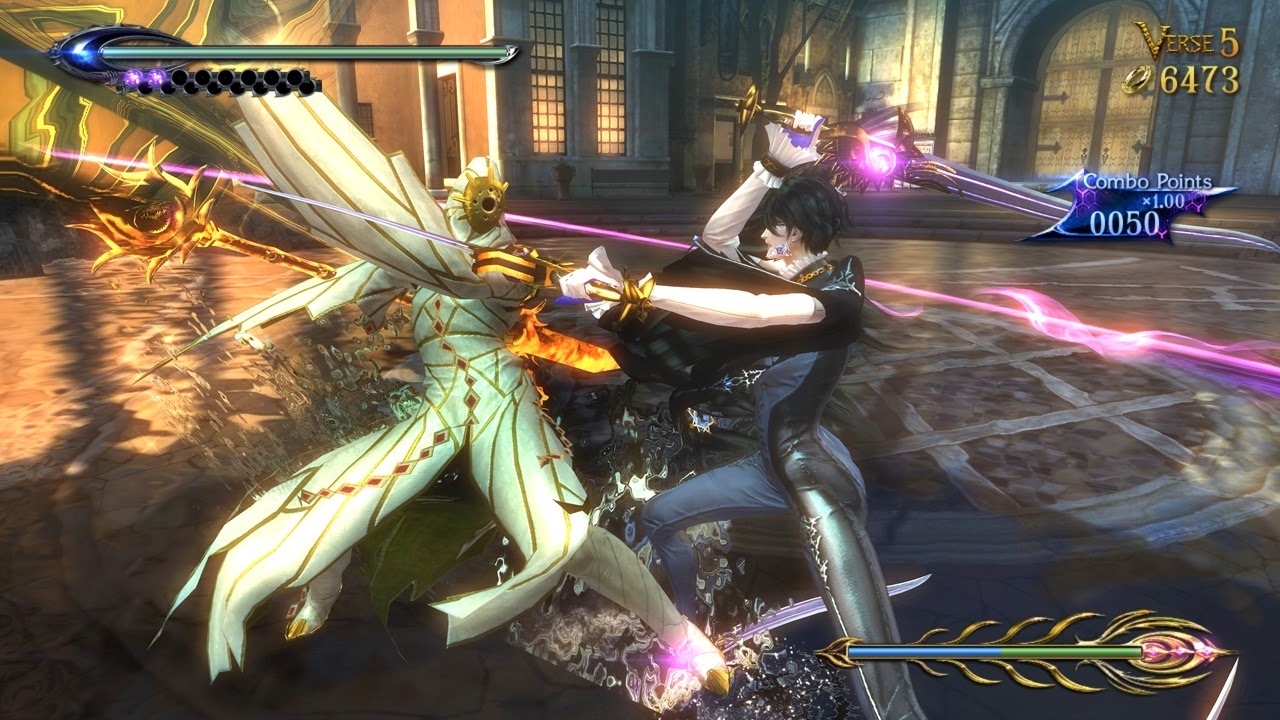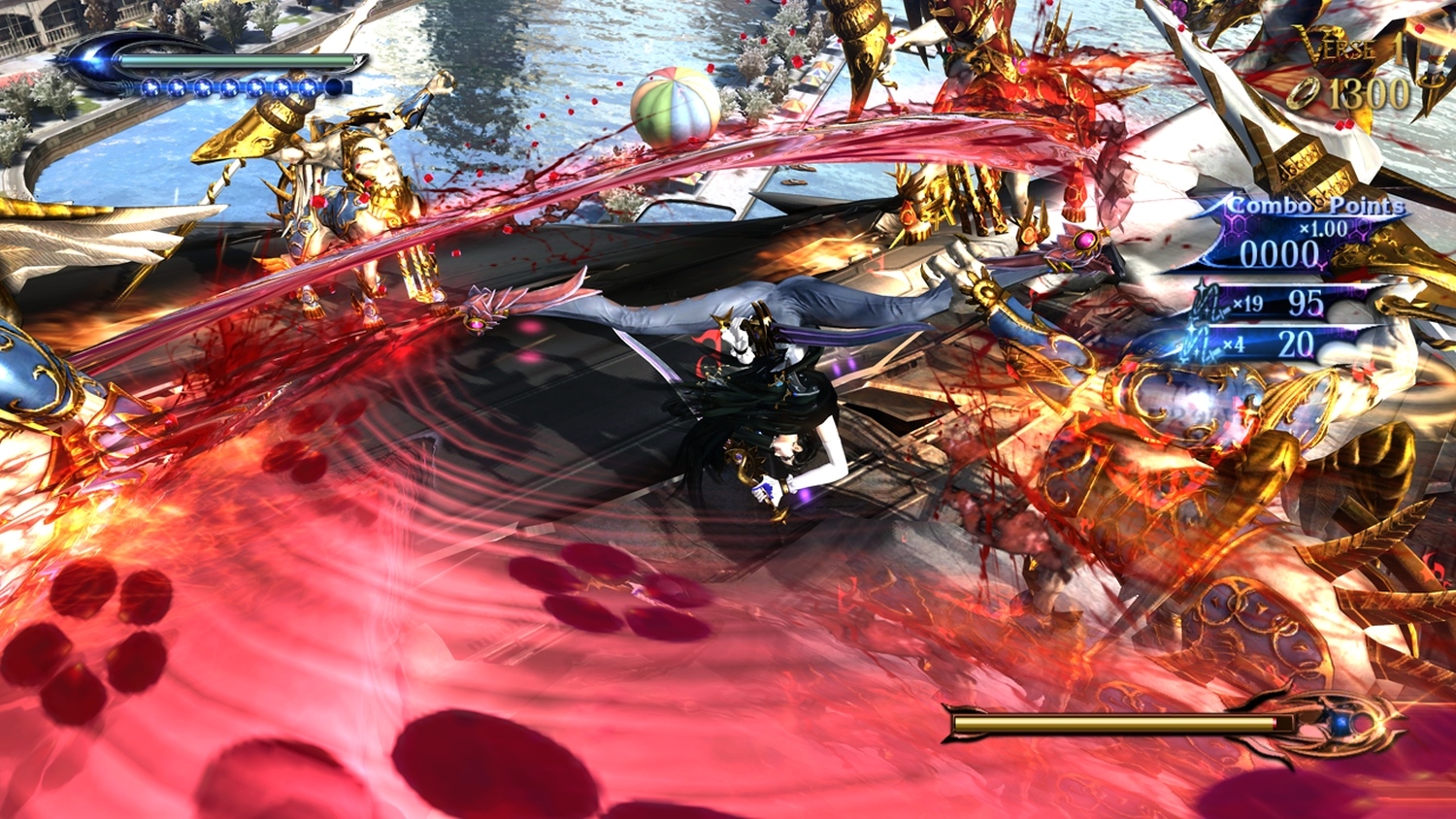 Review by Matt S.
Review by Matt S.
A tall, beautiful woman stands in the middle of a circle of angelic beings. With guns in both hands and the heels of her shoes, she is a whirling dervish of death, tearing apart the angels with impunity. The size of these creatures is irrelevant as giants try to swing at her, but she’s never where the weapon comes down, so agile is this woman that she’s already circled behind them to hit them where it hurts.
This is a bullet ballet in the purest sense; a dance of death between beings of incredible power to determine the fate of the plane. Bright, bubbly renditions of Moon River or Tomorrow Is Mine play in the background and set the mood for the dance. They’re fitting themes, because as high as the stakes of these battles are, our hero is a witty woman who has a solid grasp of just how silly the world is, and she takes this in her stride.
This is Bayonetta 2. This game makes the Wii U an essential console if you haven’t got one yet.
It would be easy to look at a screenshot or short video of Bayonetta 2 and dismiss it as yet another button-masher action game in the vein of God of War or the recent Castlevania efforts. That’s doing it a disservice. Bayonetta certainly moves with greater fluidity than Kratos and his macho compatriots (despite hitting every bit as hard), but that’s not what really puts her game apart. No, what makes Bayonetta 2 so impressive is that it actually has a theme and narrative worth paying attention to.
As mentioned, it’s a battle between heaven and hell, as told through the eyes of someone who is, in fact, aligned with hell. This broader genre is characterised by morally questionable “heroes” – Kratos isn’t exactly a nice guy, and neither are the likes of Dante from Dante’s Inferno, while Gabriel from Castlevania: Lord of Shadows, is Dracula himself, but rarely is it done with the nuance that we see in Bayonetta 2. Bayonetta is a witch that summons all kinds of demonic horrors to deal with her foes, but beneath that she has a sardonic sense of morality which seems to be more noble than the angels that she’s fighting.
Despite being clad all in white and shining with all the glory and fury of the heavens, Bayonetta’s opponents, the angels, are uncomfortable to be exposed to from the outset. Their visages are monstorous, and not the beauty winged creatures that pure good should be. The morality of Bayonetta 2’s world is far less certain that should be the case for a game in the “brainless” button masher, and while the game’s concluding chapter, as with its precessor, opts to be too explicit for the game’s otherwise subtle and nuanced investigation of the play between good and evil, it’s mentally engaging stuff getting to that point.
Naturally such a theme then comes across as a criticism of religion, and Bayonetta 2 certainly continues its predecessor’s thesis that religion sits on the wrong side of righteousness. This is going to offend some people – I can’t imagine church groups approving of this game, to but it bluntly. And that’s a pity, because taken with a critical eye Bayonetta 2 could be the focus point of some interesting discussions around the interpretations of good and evil and how they relate to religion. The same could be said about Bayonetta’s character herself. As I’ve already noted in a separate opinion piece, there are schools of feminism that are going to find the character offensive, and while I won’t go into that discussion again in this review, as a quick summary:
It’s immediately obvious why some circles of feminism are offended by this game – every camera angle in every cut scene lingers on the sexual parts of Bayonetta’s anatomy. She’s a character whose most powerful attacks requires that she become naked (her clothes are actually her hair and those attacks require using her hair to summon legions from hell). She even walks with an exaggerated femininity, like a catwalk model doing everything she can to accentiate her body. The commitment to the male gaze is strong in Bayonetta 2, and this tends to offend people.
But, equally, there is an argument to be made that Bayonetta is a perfect deconstruction of the male gaze in games. Her character is intensely aware of her sexuality, and a knowing wink to the audience makes it clear the disdain she has for the base desires of stupid men. The aura of confidence that exudes from every one of Bayonetta’s movements, supported by the fact that she is perfectly capable of taking down dragons, if not actual Gods, gives her character a lot of agency, too. Her ultimate attacks are called “climaxes,” and provide yet more evidence of the control Bayonetta has over her sexuality – she’s at her most powerful when being her most sexual. It’s an extreme kind of femininity, sure, but Bayonetta strikes me more as a celebration of female sexuality and empowerment, as per the Japanese understanding of such things; a culture in which sex is not something to be ashamed of.
If nothing else, it’s a good thing that a game, as published by a company as conservative as Nintendo, and presented to this standard, can generate such debate in the community. We need people talking about the themes in Bayonetta 2, because even though the game plays particularly well, it’s the themes that, controversial as they are, sets it apart from its hack-and-slash peers.
But the game does play very well. As I’ve already noted, Bayonetta 2 is a nimble individual, capable of ducking out of the way of an enemy attack to then counter with a brutal mix of kicks, punches and gunfire. Right from the outset of the game players have access to a wide range of moves, and the combinations only become more complex as they spend loot (“halos”) to unlock even more. Those guns that Bayonetta starts with are also eventually accompanied with additional weapons like a bow and arrow or blade. Each combination plays differently, and players are encouraged to experiment to figure out what works best for them.
On the lower difficulty levels Bayonetta 2 is too easy, but on the higher settings there will be a stiff challenge in there for most people. It’s better to play this one on the highest difficulty possible, because that helps contextualise the sheer power of the enemies that Bayonetta is fighting against, which in turn reinforces its narrative themes. For players that want to challenge themselves beyond the main story there are challenge rooms and online play, but to be completely honest I didn’t bother with any of this – the story is long enough and the action is more enjoyable within the context of the narrative.
In terms of presentation, I secretly suspect that Nintendo decided to package the original Bayonetta in with the sequel to show off how capable the Wii U is as a piece of hardware. Bayonetta, the PlayStation 3 original, is an attractive game, with its soaring gothic architecture and slick animation. But Bayonetta 2 is the most aesthetically beautiful game produced this year – and yes, that includes games like Destiny on PlayStation 4.
While the Wii U is undoubtedly not as powerful its peers, it’s powerful enough that a talented developer can still build the kind of detailed, soaring environments that make for an artful epic. From the way that light reflects off the water, right through to the detailed design of the enemies and the precise eye for architecture and accuracy that Platinum Games’ artists have, Bayonetta 2 is a visual masterpiece, and it deserves to be recognised as one. It’s especially mesmerising when the action really heats up and the bullet ballet gets into full swing. The swirl of movement and colour is nothing short of hypnotic, and it lends the game an additional bout of energy that, when set against the Gothic-inspired architecture and Asia-inspired landscapes, makes for the perfect backdrop to an epic battle between angels and demons. It’s a pity that Nintendo didn’t do a better job of encouraging third party developers to work on the Wii U, because commitment to the hardware does yield clear results, and if anything Bayonetta 2 makes me angrier that my console has sat there under the TV underused for so long. It deserves better.
When Michael Foucault wrote about his philosophical concept of the “limit”, he was talking about how we need art that push boundares – of good taste, of sexuality, of art itself – in order to define what the limit is and why we need to have it. Bayonetta 2 will challenge some people. It will make them uncomfortable. It’s transgressive in numerous ways, and with that comes the potential to offend. But in causing offence, Bayonetta 2 encourages conversation, and that’s the very definition of a good work of art.
– Matt S.
Editor-in-Chief
Find me on Twitter: @digitallydownld











